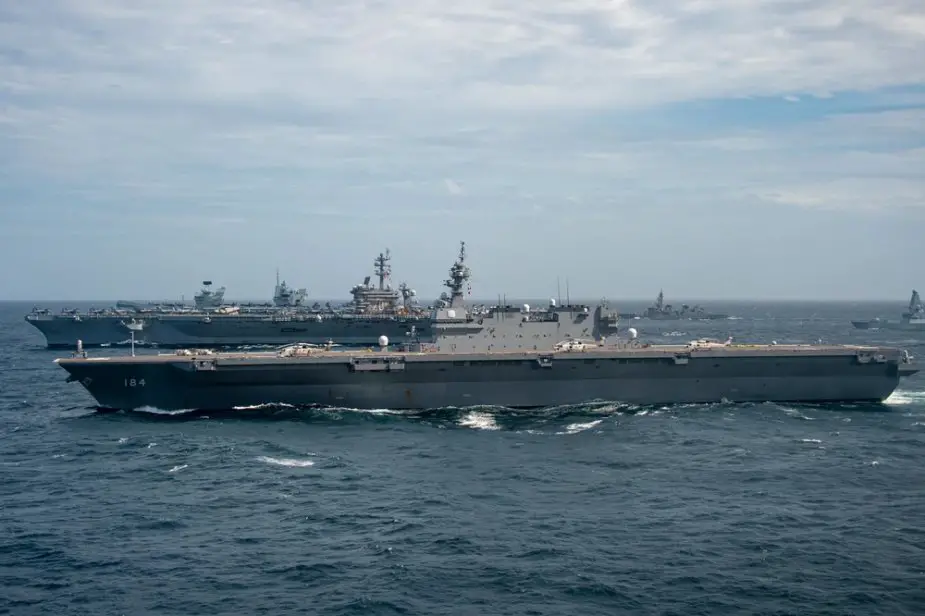Breaking news
JMSDF Izumo-class JS Kaga conducts naval drills with US Navy in South China Sea.
According to information published by the U.S. Department of Defense on October 25, 2021, Japan Maritime Self-Defense Force Izumo-class helicopter destroyer JS Kaga (DDH 184) and U.S. Navy Carrier Strike Group (CSG) 1 are conducting bilateral operations in the South China Sea for the first time since Vinson Carrier Strike Group (VINCSG) deployed this summer.
Follow Navy Recognition on Google News at this link
 U.K. Royal Navy aircraft carrier HMS Queen Elizabeth (R08), U.S. Navy Nimitz-class aircraft carrier USS Carl Vinson (CVN 70), and Japanese Izumo-class helicopter destroyer JS Kaga (DDH 184) sail together as part of MPX 2021 (Picture source: U.S. Department of Defense)
U.K. Royal Navy aircraft carrier HMS Queen Elizabeth (R08), U.S. Navy Nimitz-class aircraft carrier USS Carl Vinson (CVN 70), and Japanese Izumo-class helicopter destroyer JS Kaga (DDH 184) sail together as part of MPX 2021 (Picture source: U.S. Department of Defense)
While in the South China Sea, Japan and U.S. Navy units are conducting maritime security operations, to include flight operations, coordinated tactical training between surface and air units, refueling-at-sea evolutions, and maritime strike exercises.
Cooperative maritime engagements and U.S. carrier operations in the South China Sea are part of the U.S. Navy’s routine presence in the Indo-Pacific.
Since arriving in the U.S. 7th Fleet region, CSG 1 units have participated in multiple operations and exercises with JMSDF units, most recently MALABAR 2021 and Maritime Partnership Exercise. JMSDF Rear Adm. IKEUCHI Izuru, Commanding Officer of IPD21 force, Commander of Escort Flotilla 3 said maritime alliances and partnerships are vital to maritime security and underpin the free flow of commerce and access to resources in the region.
Led by Carrier Strike Group (CSG) 1, U.S. Navy units operating in the SCS include aircraft carrier USS Carl Vinson (CVN 70); Ticonderoga-class guided-missile cruiser USS Lake Champlain (CG 57) and USS Shiloh (CG 67); Arleigh Burke-class guided-missile destroyer USS Stockdale (DDG 106) of Destroyer Squadron (DESRON) 1; and nine squadrons of embarked Carrier Air Wing (CVW) 2.
CVW-2 consists of an F-35C squadron, the “Argonauts” of Strike Fighter Squadron (VFA) 147; three F/A-18E/F Super Hornet squadrons, the “Bounty Hunters” of VFA-2, the “Stingers” of VFA-113, and the “Golden Dragons” of VFA-192; the “Gauntlets” of Electronic Attack Squadron (VAQ) 136, operating the EA-18G Growler; the “Black Eagles” of Airborne Command and Control Squadron (VAW) 113, operating the E-2D Advanced Hawkeye; the “Titans” of Fleet Logistics Multi-Mission Squadron (VRM) 30, operating the CMV-22B Osprey; the “Black Knights” of Helicopter Sea Combat Squadron (HSC) 4, operating the MH-60S Seahawk; and the “Blue Hawks” of Helicopter Maritime Strike Squadron (HSM) 78, operating the MH-60R Seahawk.
This marks the second time that a carrier strike group is operating in the South China Sea with the advanced capabilities of the F-35C Lightning II and Navy CMV-22B Osprey.
JS Kaga (DDH-184) is a helicopter carrier with a planned future conversion into an aircraft carrier. Officially classified as a multi-purpose operation destroyer, she is the second ship in the Izumo class of the Japan Maritime Self-Defense Force (JMSDF).
The JS Kaga can carry up to 28 aircraft, or 14 larger aircraft. However, only 7 anti-submarine warfare helicopters and 2 search and rescue helicopters are planned for the initial aircraft complement. For other operations, 400 troops and 50 3.5-ton trucks (or equivalent equipment) can also be carried. The flight deck has five helicopter landing spots that allow simultaneous landings or take-offs.
The JS Kaga is armed with two Phalanx CIWS (Close-In Weapon Systems) and two SeaRAM CIWS.





























